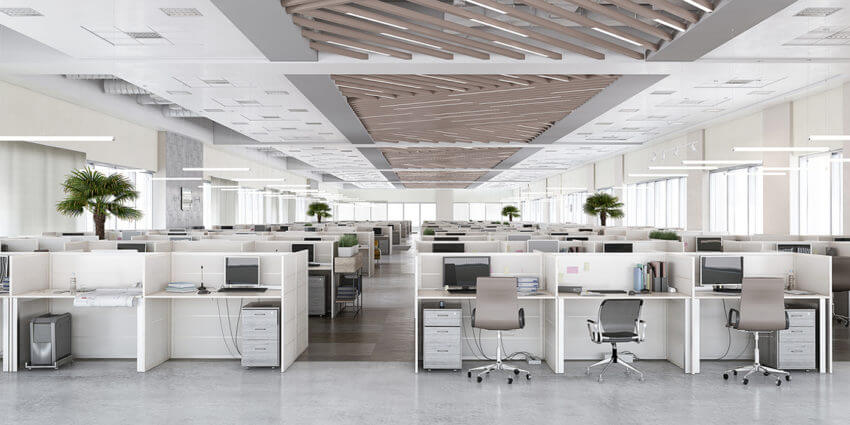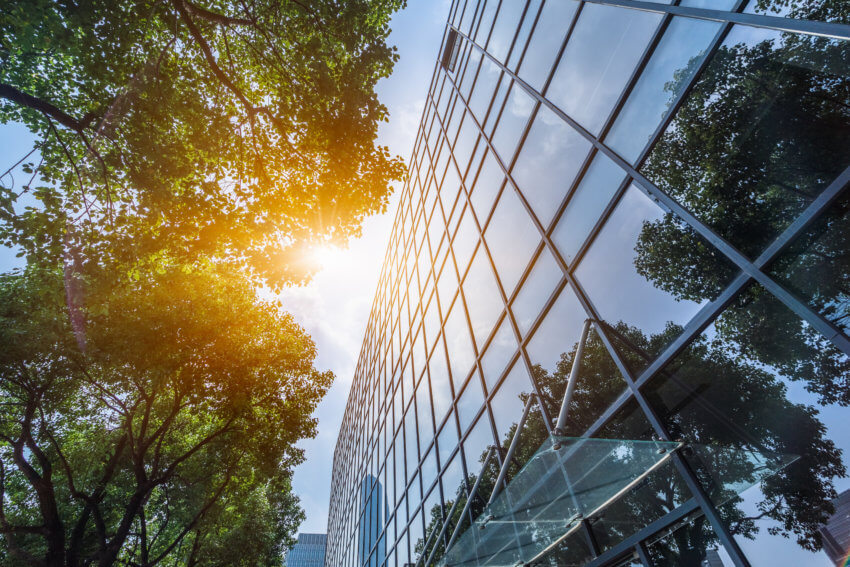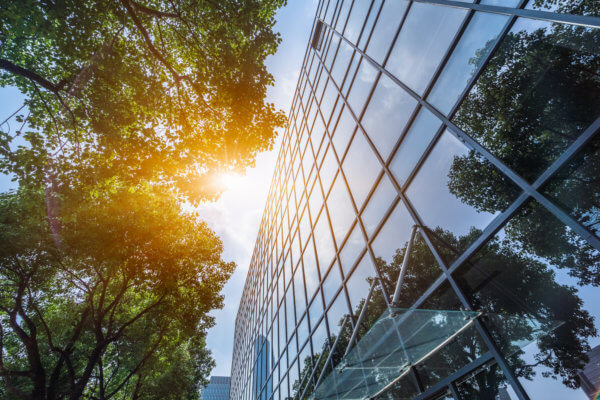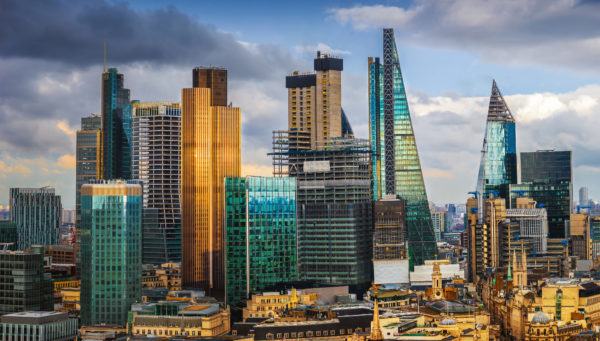How to design the perfect workplace
Most of us will spend around a third of our adult lives at work – that’s an average of 35 hours a week, or about 90,000 hours over a lifetime. Our workplaces should be inviting, responsive to our needs, and supportive of our environmental values.
Over time, poorly designed, unappealing workspaces affect the morale of employees, lower productivity and increase employee turnover. By contrast, a workplace designed to enhance the employee experience will help reduce employee stress and increase employee satisfaction.
Research from Gartner* found that employees who are satisfied with their workplace are 16% more productive, 18% more likely to stay and 30% more attracted to the organisation than its competitors. So, it doesn’t just affect our employees’ wellbeing, in the battle for top talent, the workplace experience can influence our organisation’s ability to attract and keep them.
Creating the right workplace environment is essential to the success of any organisation.
*Make Your Digital Workplace Employee-Friendly With These Six IoT Best Practices(Gartner)

Using workspace design to create a great environment
Designing the perfect workplace takes creativity but also a thorough understanding of your team’s specific needs and requirements. These can be influenced by everything including job role, age and ethnicity.
According to the Indeed Work Wellbeing Insights Report 2022*, only 44% of the respondents said their organisations were measuring health and wellbeing factors in the workplace.
It’s vital that these factors are catered for, and your employees can see that their needs are taken seriously.
With a better understanding of their needs, and the means to meet them, you will be rewarded with improved morale and increased productivity.
*Working on wellbeing: Mental health and wellness in the UK workplace. 2022 report (indeed.com)
Observe your teams’ dynamic
Start by asking your employees what they think of their workspaces and the general workplace experience.
Get a picture of how your teams work together and use the different spaces. Are your teams deskbound or physically active and do the workspaces help or hinder collaboration?
In one example, that some might consider extreme, a leading technology company updated its offices to offer 75 different variations of seating to support its flexible working options. That’s impressive, if unachievable for most. But, do you know which of your work areas are used most and how they are used?
Collaboration is undoubtedly important to your organisation, but what’s the best way to achieve it in your offices? Ask your teams how they would benefit from breakout rooms and common spaces, and what they would need to help them share ideas across teams.
If these considerations haven’t been factored into your original workspace design, it’s not too late to incorporate them now.
At Mitie, we use Sphere, our workplace effectiveness measurement tool, to facilitate design changes. The tool uses tailored questionnaires to collect data on physical, sensory and emotional aspects of our customers’ workplaces. The analysis gives our workplace design team detailed insights into how the different spaces affect employees’ productivity, wellbeing and attitudes to work. And it gives our customers a clearer picture of what works for their employees and what could be improved to enhance their workplace experience.
Design with culture in mind
Organisational culture should be another significant factor in your designs. For example, some professional services companies, like lawyers or accountants, might prioritise a serious and sophisticated image. By contrast, a graphic design company might want a creative, vibrant office, with an emphasis on colour and imagery. Every organisation is different.
Either way, organisational culture should be reflected in your workplace design. Choices in workplace design help employees adopt the right mindset while in the office and tell visiting customers that they’re in the right place. Having said that, it can be good to shake things up by doing the unexpected, if that works for your organisation and doesn’t send confusing messages to your customers.
Implement collaborative workspace design
Collaborative workspace design encourages interactions, especially between colleagues in different teams who might not meet every day. Principles of collaborative workspace design include:
- Making the most of unused space, by installing comfortable chairs and tables to encourage impromptu meetings.
- Providing spacious and inviting break-out areas, alongside private meeting spaces, where employees can meet and talk freely.
- Creatively using artwork and graphics to boost productivity and innovative thinking.

Workspace design aspects to consider
Good workspace design incorporates tried-and-tested principles that promote employee wellbeing and motivation. Especially when backed up by data-led insights and technological solutions, like environmental sensors that monitor comfort levels.
Make workspace management easy
Do you have an effective way for employees to check meeting space availability, or raise an alert when something breaks? A workspace is more than just a room, and good designs also need to encompass your digital workplace.
Using technology, like electronic room booking systems, can take the hassle out of meeting and space management. Aria, our workspace management app, allows employees to book meeting rooms remotely, and even order refreshments to their desks, if they choose. Also, using its chat facility, they can easily report FM issues and get a quicker response which reduces the frustration of waiting for solutions. Employees feel heard, and more in control of their workspaces, which also helps to improve productivity.
Light the way
While it can’t always be avoided, harsh artificial light can have a negative impact on your employees’ wellbeing. By contrast, natural light increases focus and productivity, promotes higher levels of happiness and improves physical health.
In a survey of 7000 office workers conducted by UK stationers, Staples, 80% said that good lighting in their workspace was important to them. And a third said improving the lighting would make them happier and more productive in the workplace.
Whether it’s artificial or natural, bright lighting is essential for focus and stress-reduction. A combination of both should be used and environmental sensors can help make sure that the right levels are achieved and maintained.
Also, while you’re making changes, it’s an excellent opportunity to phase out less efficient lighting systems and introduce energy savings by installing environmentally friendly LEDs.
Modular design
Undoubtedly you will have some constraints driving how you plan your workplace, however there may be other components in your office that can be rearranged in response to varying needs.
Ask your employees how they prefer to work. If you already use a modular format, consider incorporating technology, like footfall sensors, to see which areas are used most often, and which set-ups don’t work for your employees.
The insight you get, as a result, could allow you to reduce or redesign your workspace to suit actual usage. For example, switching from designated seats to hot desks, could be a more effective use of space and could cut costs.
The circular economy
Where possible, find opportunities to reuse materials, or purchase and refurbish second-hand. There are online platforms that help organisations to find ethical and environmentally friendly ways to dispose of unwanted resources. At Mitie, we also help our customers with pre-loved resources to find organisations that can use them.
Tapping into the circular economy is important for your organisation’s Environmental, Social and Governance initiatives, and it will also save you money. It’s covered in our whitepaper, Accelerating Facilities Transformation, which is available to download.

How can Mitie help with your organisation’s redesign requirements?
At Mitie, our workplace design team works with organisations in the public and private sectors across the UK and Ireland. As part of the UK’s largest FM company, our team of specialists have access to a wide range of complementary services which enable a seamless end-to-end delivery. We combine an extensive knowledge of design trends, with expertise in the latest workspace and project management technology.
Our workplace design is central to our transformational Science of Service® offering.
Enquire now to see how Mitie can support your organisation’s redesign requirements.
Read next

How to design your office for wellbeing
Many of us spend long hours at work, so it’s only right that the environment is responsive to our needs as human beings. When it comes to wellbeing, office design is central. If a workspace is…

Mitie bolsters hybrid workspace evolution with the launch of Sphere
Mitie has launched Sphere, its new technology solution to help businesses design the most effective workspaces for their people.
Extracting real value from data generated from workspace sensors
Our buildings are becoming more and more ‘intelligent’. Thanks to Internet-of-Things (IoT) connected devices that allow us to more effectively monitor and control building operations, the amount of data that we’ll be able to…